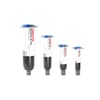LOCTITE ECCOBOND UF 3810
Harmonization Code : 3907.30.00.90 | Polyacetals, other polyethers and epoxide resins, in primary forms; polycarbonates, alkyd resins, polyallyl esters and other polyesters, in primary forms : Epoxide resins : Other
Main features
- High Tg
- Halogen free
- Reworkable
Product Description
LOCTITE® ECCOBOND UF 3810 reworkable, epoxy underfill is designed for CSP and BGA applications. It has high Tg and has stable electrical performance in temperature himidity bias. This material cures quickly at moderate temperatures to minimize stress to other components. When cured, it provides excellent mechanical properties to protect solder joints during thermal cycling.
LOCTITE® ECCOBOND UF 3810 is a single component, halogen free black material, compatible with most Pb-free solders. It can flow in temperature and cure fast at moderate temperatures.
Cure Schedule
- ≥8 minutes @ 130°C
Technical Specifications
| General Properties | |||||||||||
| |||||||||||
| Specific Gravity Specific Gravity Specific gravity (SG) is the ratio of the density of a substance to the density of a reference substance; equivalently, it is the ratio of the mass of a substance to the mass of a reference substance for the same given volume. For liquids, the reference substance is almost always water (1), while for gases, it is air (1.18) at room temperature. Specific gravity is unitless. | 1.13 | ||||||||||
| Physical Properties | |||||||||||
| Viscosity Viscosity Viscosity is a measurement of a fluid’s resistance to flow. Viscosity is commonly measured in centiPoise (cP). One cP is defined as the viscosity of water and all other viscosities are derived from this base. MPa is another common unit with a 1:1 conversion to cP. A product like honey would have a much higher viscosity -around 10,000 cPs- compared to water. As a result, honey would flow much slower out of a tipped glass than water would. The viscosity of a material can be decreased with an increase in temperature in order to better suit an application | 394 mPa.s | ||||||||||
| Chemical Properties | |||||||||||
| |||||||||||
| Mechanical Properties | |||||||||||
| |||||||||||
| Thermal Properties | |||||||||||
| |||||||||||
| Glass Transition Temperature (Tg) Glass Transition Temperature (Tg) The glass transition temperature for organic adhesives is a temperature region where the polymers change from glassy and brittle to soft and rubbery. Increasing the temperature further continues the softening process as the viscosity drops too. Temperatures between the glass transition temperature and below the decomposition point of the adhesive are the best region for bonding. The glass-transition temperature Tg of a material characterizes the range of temperatures over which this glass transition occurs. | 102 °C | ||||||||||



